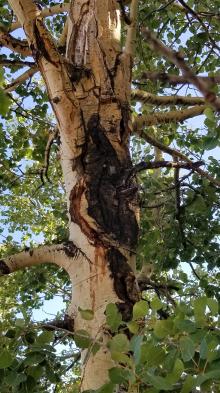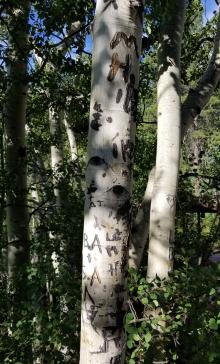See:
Poplar (Populus spp.) - Canker
Cause The fungus Ceratocystis fimbriata causes a canker disease that has been reported as common in surveys of Oregon and Washington. The fungus is vectored by many different beetles and some flies that are attracted to fresh wounds. Wounds may be in the form of branch stubs, primary insect attack, fire scars, or any other physical injury. Infected trees are susceptible to wind breakage. Black canker is usually slow growing, taking years to kill individual trees.
Other canker diseases include sooty-bark, Cryptosphaeria, and Cytospora cankers. Cytospora commonly shows up as a secondary invader of the already dead tissue.
Symptoms Cankers are perennial but slowly expand each year resulting in a zonate elliptical area. Sometimes called a "target canker" based on these symptoms. These lens-shaped areas are about 1.5 feet long and sunken. Bark in the canker is blackened but may look varnished due to orange dried sap exudations. Cankers can occur anywhere along the stem or branch. Twigs, branches, and trees are killed once girdled. Secondary problems, such as other cankers and insects, can move in and kill these stressed trees.
Cultural control
- Keep trees in good vigor and avoid wounding.
- Remove and destroy cankered trees.
- Partial harvest of stands is strongly discouraged.
Reference Callan, B.E. 1998. Diseases of Populus in British Columbia: A Diagnostic Manual. Natural Resources Canada. Canadian Forest Service, Pacific Forestry Centre, Victoria, B.C. 157p.



